|
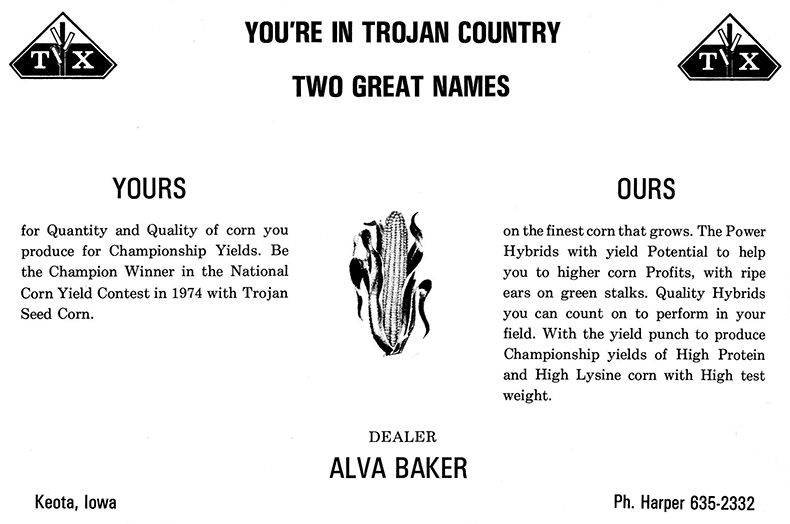
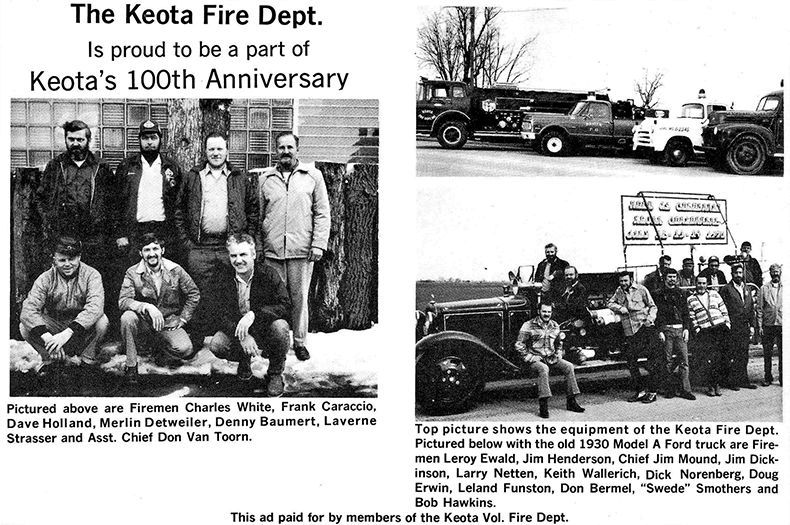
101
A glimpse into the past...
August 1, 1912.
Dr. D.C. Brockman of Ottumwa has donated a set of 25 science books to
the Keota Public Library including Tyndall, Huxley, Spencer, Darvin,
Kant, Bacon and others.
July 20, 1922.
The Culture Club has made arrangements with Mr. Darbyshire, manager of
Iowa Gas and Electric Company, to operate a free public library in
their Keota office. The state traveling library has been used before in
Keota. A set of fifty books will be sent out on loan every three months
and then they are exchanged. The books are open to the public free of
charge. The public is asked to help this enterprise by donation of
books or money. The library will be open by July 29.
April 5, 1923.
The Culture Club wishes to thank their friends who have donated books
to their free public library. The State Library has loaned one hundred
books and they were recently exchanged. Books may be borrowed only on
Wednesday and Saturday from 2:00 until 5:00.
May 24, 1923. The
Culture Club moves the library from Iowa Gas and Electric Office to a
room Mr. F. F. Marsh has opened. It is just one door east of the old
location.
May 31, 1923. The
Town Improvement Society has turned over to the Culture Club the books
that belonged to them. 275 books have been selected, which includes a
large number of books for boys and girls.
December 4, 1924.
The Culture Club is moving the library today from the Commercial Hotel
to Dr. Irelan's office, where it will be re-opened Saturday.
April 10, 1941.
The town council of Keota passed an ordinance establishing a tax
supported free public library in Keota. They accepted the Culture Club
library, operated as a free library for the past quarter century by the
ladies of this club. The management will be entrusted to a board of
nine trustees, all members of the club. The committee will levy and
spend the necessary tax monies, hold regular meetings and make an
annual report to the town council. In case the council should decide to
terminate the public library it will revert back to the Culture Club.
Trustees appointed are Mrs. Edith K. Pulver, Mrs. A.F. Mitchell, Mrs.
C.O. Harris, Mrs. C.A. McCampbell, Mrs. C.R. Sturgeon, Miss Harriet
Clendenning, Mrs. F.M. Herr, Mrs. H.W. Statler and Miss Kate B. Glover.
They will receive no compensation for their services. Mrs. Edith Pulver
is serving as librarian under a federal recreation project.
WILSON
MEMORIAL LIBRARY
In October 1949,
R. O. Wilson willed the Town of Keota a large sum for the purpose of
building a fireproof public library, also all the books in his personal
library. It is to be built on the tract in the north part of town known
as the S. K. Leacox place, and it must be accepted or rejected within
one year of his death. He asked that some member of the Keota, Iowa,
Chapter of the P.E.O. Sisterhood, in which organization his beloved
sister was interested, be appointed a member of the Library Board of
said town.
In May 1950 the
Town Council voted to accept the bequest which is expected to amount to
between $70,000 and $80,000.
On Monday, June
16, 1952, the Town Council took a definite step in the direction of
building a fireproof library building in Keota. They employed H. B.
Sowden of Washington as the architect to draw up the plans for the
library.
February 12,
1953, at a special meeting of the Town Council the McKey-Fancher
Construction Company of Oskaloosa, Iowa, was awarded the general
contract on their low bid of $32,008, a figure which includes an
alternate of $423 for insulation within the brick walls of the
structure.
The Pierson &
Pierson Company of Fairfield, Iowa, was awarded the plumbing and
heating contract on their low bid of $5,000.
Keota Electric
Company of Keota had the only bid on the electrical contract and it was
awarded for $2,728.73.
Representatives
of the local Library Board and the Council's Library committee met
prior to the Thursday night's full council meeting and chose the brick
to be used in the new building. It is an Ottumwa brick of buff color
and rough finish. Some of the bricks are to be of a darker buff for a
slightly variegated effect. A similar brick of smooth finish will be
used inside to make the rooms light.
The 40 x 50
building will stand on the corner of the old Leacox property in the
north part of town.
The net estate
after court, administrators' and several attorneys' fees and other
costs amounted to about $72,000.
Work is to begin
March 1st or soon thereafter and to be completed by approximately July
1, 1953.
The Town Council
at a special meeting with the engineers and contractors on December 29,
1953, approved the new building which has been under construction for
about ten months.
The Council and
the Municipal Library Trustees now have the task before them of buying
what additional furniture is needed, of buying perhaps thousands of new
books, and getting the present library moved from the present City Hall
to the new building.
The Library has
what is called a half-basement, being partly below ground and mostly
above, with the Library on the first or main floor. It is of two-tone
buff colored brick, with some capping around the top, flat roof, huge
fluted glass and aluminum windows of the louvre type operated by
cranks, with storm windows and screens convertible, oil furnace and hot
water forced heat, men's and women's toilet rooms, a large basement
room reserved for future development. The upstairs library rooms are
positioned so that one librarian can see just about every nook and
cranny. There are metal stacks and blonde oak shelving for many
thousands of books, and two large spaces for reading tables. The floor
is tiled and the lights are instant fluorescence. The glassed-in
two-way entrance gives access to a lobby leading upstairs and down. The
ground outside has a gentle slope to the new sidewalks and will be
sowed to grass in the Spring.
102
A glimpse into the past...
The building is
one of the most modern and best looking buildings in Keota and is as
fireproof as science can make it.
Cut in the stone
of the south capping are the words "Wilson Memorial Library."
The Council has
invested $20,000 in bonds for future maintenance of the building and it
has approximately $8,000 still on hand for the purchase of furniture,
books and other incidentals.
The new Library,
like the present one, will be operated by nine municipal trustees who
serve six-year terms staggered so that three trustees' terms expire
every two years. The trustees are appointed by the Mayor with consent
of the Council. The trustees are organized as follows: President, Mrs.
F. M. Herr; Vice-President, Mrs . H. W. Statler; Recording Secretary,
Mrs. Besse Huber; Financial Secretary, Mrs . Walter Stoutner; and five
others, Mrs. Logan Schreckengast, Mrs. Mack Glass, Mrs. Valburga White,
Mrs. Mae Sturgeon and Mrs. Kay Statler.
The Wilson
Memorial Library opened for business on June 29, 1954, with Mrs. Bea
McNurlen as Librarian.
Present officers
of the Wilson Memorial Library are as follows: President, Mrs. Tressie
Schreckengast; Vice-President, Mrs. Elva Statler; Secretary, Mrs.
Lucille Werning; Treasurer, Mrs. Valburga White; Board, Ruth Zehr, Joye
DeLong, Betty Dill, Bernice Mattison, Catherine Malley (Librarian).
These accounts
were taken from The Keota Eagle.
**********
December 7, 1916.
Charles A. Gray, the artist, has spent the summer doing landscape work
along Dutch Creek and the Skunk River.
May 28, 1925. The
mayor interviewed some Keota boys recently on the subject of the buying
and smoking of cigarettes by minors. Nothing drastic was done, but we
presume there will be some action taken if the cigarette laws are
openly violated.
**********
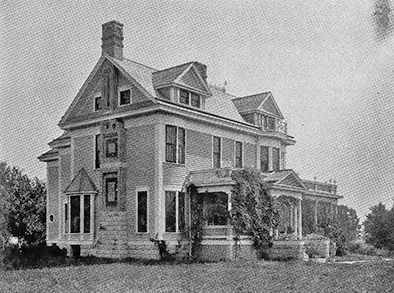
"Maplehurst" home of Mr. and Mrs. C. F. Singmaster built in 1895.
Later the home of Mr. and Mrs. C. A. Singmaster and family. |
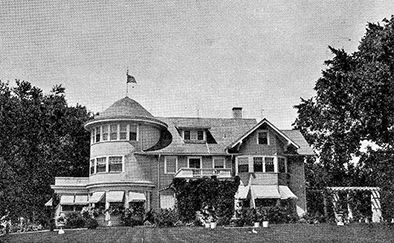
"Maple Villa" at Maple Grove Farm. Home of
Mr. and Mrs. J. O.
Singmaster & Son. Built in 1917. |
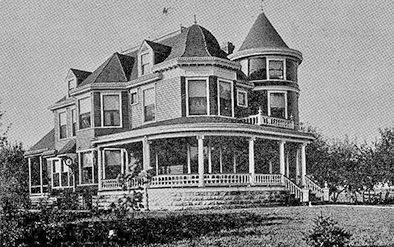
Home of J. O. Singmaster family before 1917. |
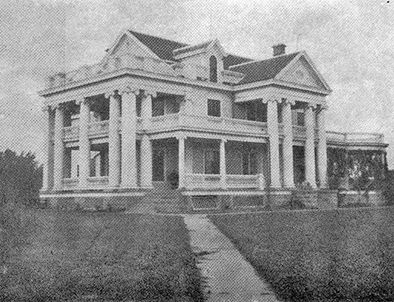
"Elmhurst" Home of Mr. and Mrs. Thomas Singmaster and family.
Built in 1905. |
103
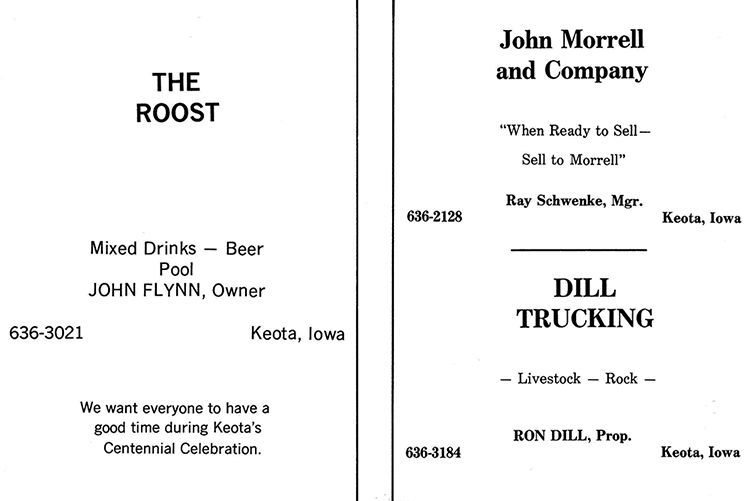
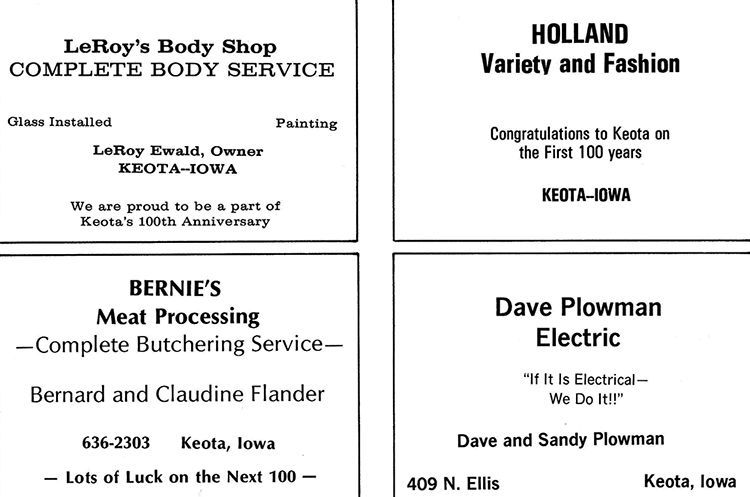
104
A glimpse into the
past...
ELECTRIC POWER
FOR KEOTA
February 23,
1899. ELECTRIC LIGHTS FOR KEOTA!! WHEW!!
May 25, 1899.
They shipped the big steam engine for the electric light plant from
Muscatine Tuesday and placed it in the engine room that is now in the
course of construction at the Oatmeal Factory. It is a 108 horse power
Atlas Machine with two boilers of 60 H.P. each to run it. The fly wheel
is nine feet in diameter and has a 17 inch rim.
September 7,
1899. Keota has electric lights. Wm. J. Pugh is the machinist. The
electric light engines burn an even carload of coal slack — 20 to 25
tons each per week.
December 25,
1902. The Electric Light people wish to notify all patrons through The
Eagle to be as economical as possible in the use of light for they are
having a hard time to keep sufficient coal on hand to enable them to
run at all.
January I , 1903.
The signal for the shut-down of the electric lights will be one long
blast of the whistle, a half hour before the time. The blinking of
lights which was the signal used before is wearing on machinery.
Notice of
Incorporation
February 13,
1902. Notice is hereby given that a corporation named "The Keota
Lighting Co." has been organized under laws of Iowa. The general nature
of the business shall consist of erection, acquiring, maintaining,
constructing and operating electric light and power plants together
with the right to acquire all necessary property, real, personal or
mixed necessary for operating such plants.
Capital stock of
the company shall be $20,000 in shares of $100 each with authority to
begin business when $10,000 has been subscribed and paid in.
Corporation exists from January 23, 1902, to continue twenty years.
Until the first annual election the board consists of J. H. Vail, C. O.
Dayton, A. A. Shrader and E. H. Vail. Dated at Keota, February 12,
1902. A. A. Shrader, President; E. H. Vail, Secretary.
From September
29, 1904, The Keota Lighting Company was under new management every so
often until about 1915. They seemed to have trouble keeping the light
plants in working order and the town was without lights much of the
time. March 11, 1907, The Keota Lighting Company was sold at Sheriff's
Sale to J . W. Harding and L. H. Smith for $4640. At that time the
future of the Keota Lighting System was undecided. After about two
months of darkness, December 19, 1907, The Keota Light Plant was again
in operation and Broadway was lighted on a Saturday night. This did not
last for on October 23, 1907, the last run was made and all "glirn
doused" for good. Keota people were rustling up old gas lamps, oil
lamps and lanterns. The shutting down of the light plant had caused
resurrection of old dingy, forgotten lamps from attics and sheds and
the sale of wicks, burners and chimneys was astonishing. It made the
people realize the value of lighted streets.
June 13, 1907,
the Mayor of Keota received this letter from state agent of "The Home
Insurance Co. of New York" with office in Des Moines in regard to the
condition of electric wiring in Keota. In conversation with the manager
of the Electric Light Company, he was advised that the wiring
throughout the town was in poor condition and surprised the whole town
hadn't burned up. He said in many cases the wires were laid loosely
across ceiling joists in attics of buildings and in contact with gas
pipes, all showing that little attention was paid to underwriting
rules. He requested that this matter be taken up immediately with
proper authorities and have it remedied. A loss recently on the
dwelling of Tom Singmaster's was attributed to defective wiring.
By 1916, The
Burlington Railway and Light Company had taken over the lighting plants
of Keota. They were to connect all the plants they owned with Keokuk
Dam Power. The new electric system had been installed and the electric
current had now been changed from direct to alternating current. The
new service was to be so much better than the old.
1917 found the
Iowa Gas & Electric Company operating in Keota and were placing
poles along the alleys of Broadway and the wires were soon to be off
the main street. Gilbert Johnson was superintendent in charge.
May 29, 1919.
Keota is raising funds with which to install eight electroliers in each
of the three blocks on Broadway, from Page's Black smith Shop to
Singmaster's Barn on the west end of the street. There will be eight in
a block, four on each side and directly opposite each other. The wiring
will be underground — the city will furnish or pay for electricity
consumed. The Iowa Gas & Electric Company agreed to place the 24
posts and wiring for $1040.
January 15, 1925.
Keota is to receive the first sample of the new electric current from
Washington today.
July 30, 1925.
The Keota Office of Iowa-Electric Southern Utilities Co. is being
combined with Keota Electric Co. The I.S.U. will rent office space of
Mr. Flave Hagist and Mr. Hagist will be lineman and meter reader.
September 30,
1926. The rest of the light poles were taken off the business blocks of
Broadway and five or six blocks are entirely rid of unsightly poles and
wires.
December 22,
1938. The town of Keota now has some street lights that burn all night.
They are suspended over the center of Broadway at the intersections
near the Keota Creamery, the Post Office, the Keota Lumber Yard and at
the alley across from Berend's.
The Iowa Southern
Utilities Company which serves the Keota area with electrical power has
made many improvements in their wiring, etc., over the years. It was in
March 1966 that the old incandescent street lights were replaced with
mercury vapor lamps.

105
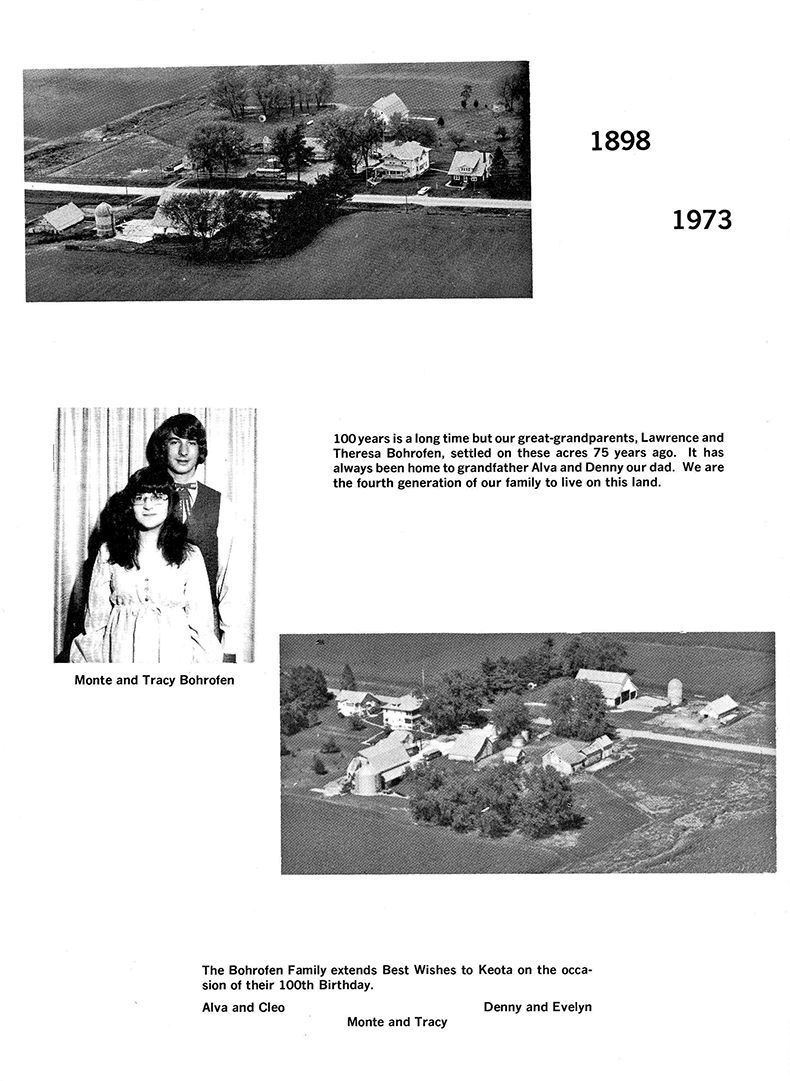
106
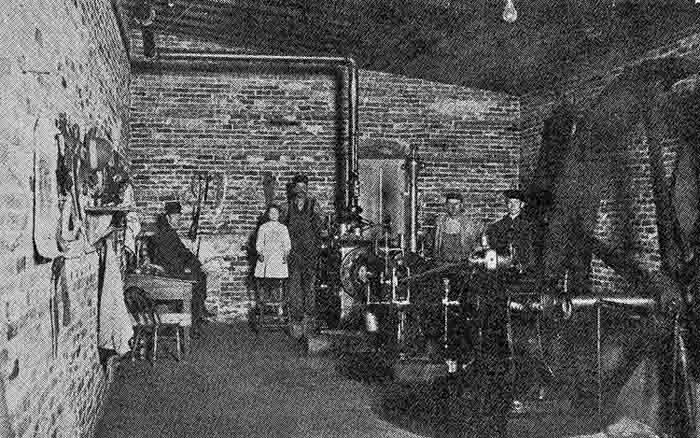
Keota's first electric light plant—
1899
Brick building today is used as storage place for Iowa Southern
Utilities.
KEOTA'S HOTELS OF THE PAST
The Everett House
In September of
1872, L. A. Norton came to the new town of Keota from Talleyrand and
built what was called the "Everett House." Norton operated it as
Keota's first hotel for a number of years and it was considered "quite
a famous hostelry in those days."
It stood at the
Southeast corner of Broadway and Fulton streets, north of the depot.
It later became
known as the Hammes building and in September, 1904, W. R. Charlton
bought the old building of Dr. C. A. Trumbauer. Later with the help of
Sam Shrader, Harvey Hogue and others the building was moved to
Charlton's vacant lot on Davis Street opposite George R. Divelbiss. Mr.
Charlton remodeled the old building into a residence.
**********
In 1887 the
"American House" on West Broadway was a popular hotel.
Single Meal — 25¢
Board by the day — $1.00
Board by the week — $4.00
J. O'Brien, Proprietor
**********
In March 1889 the "Central House" was opened.
H. T. Willis, Proprietor
**********
There was also
the "Keota House" listed in 1898.
**********
LINDLE
HOTEL
It is not known
when the Lindle Hotel was built but it was one of the town's early
landmarks. Mr. and Mrs. J. B. Warrington were married in 1868 and came
to Keota in its earliest days and operated the "Lindle House" as it was
called then. In 1887 the Lindle Hotel was said to be a fine two-story
frame building erected at a cost of $4,000.00. In 1895 it was called
the pioneer hotel of the city. It was located on North Fulton Street,
one block north of the depot. It had 25 rooms.
September 19,
1901. The Lindle Hotel manager is H. T. Willis.
February 6, 1913.
The Lindle Hotel had a new manager, H. A. Arnold, with Verdi Henry as
cook, one of the Teets girls as chamber maid and Marie Burke, waitress.
March 25, 1915.
The Lindle Hotel had a new owner, S. H. Lawrence. In 1916 Mr. E. R.
Isaac was the new owner of the Lindle. He made wonderful improvements
around the premises. They had a grand opening the afternoon and evening
of June 8, 1916. Sunday dinner was 35¢.
**********
THE
COLUMBIAN HOTEL
The Columbian
Hotel occupied the fine two-story brick building erected at a cost of
$10,000 in 1894 by J. K. Bryson & Son, with Mr. H. T. Willis as the
first proprietor and landlord. At its grand opening about 150 to 200
guests made the tour of inspection. There were 21 rooms all neat and
attractive including a parlor with piano. The dining room would seat 40
people. There was an office and a large and commodious sample room for
the use of its commercial guests.
March 8, 1906 the
Columbian Hotel changed its name to the Commercial Hotel. It continued
to be called the Commercial Hotel until 1927, when Mr. and Mrs . G.
Simmerman, after a complete renovation — re-decorating and reequipping
— opened under the name "Hotel Keota." It was opened to the public
Sunday, March 27, 1927, for noon dinners. The hotel now had 15 rooms,
more than half with running water and a large dining room.
In 1936 the Town
of Keota took over the Hotel Keota, receiving a tax deed from the
county which it had acquired for delinquent taxes. The town council
immediately established a public ladies' rest room. Mr. and Mrs. George
Simmerman continued to run the hotel. The lower part became the Town
Hall and at present the building is owned and occupied by "The Long
Branch."
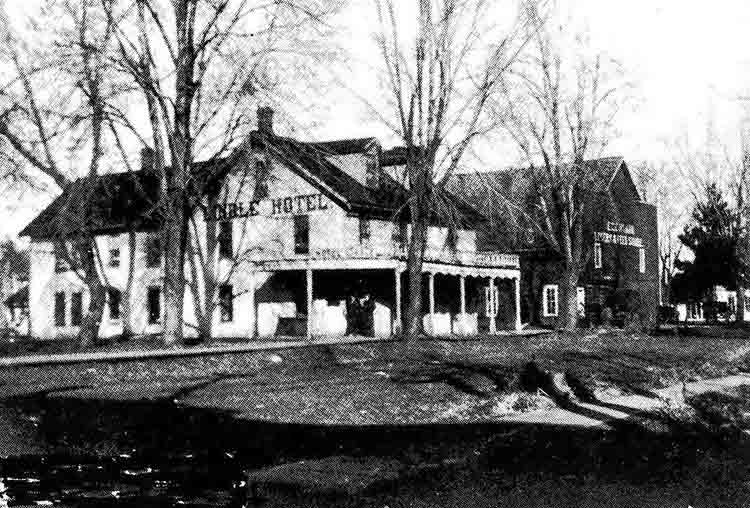
Lindle Hotel
107

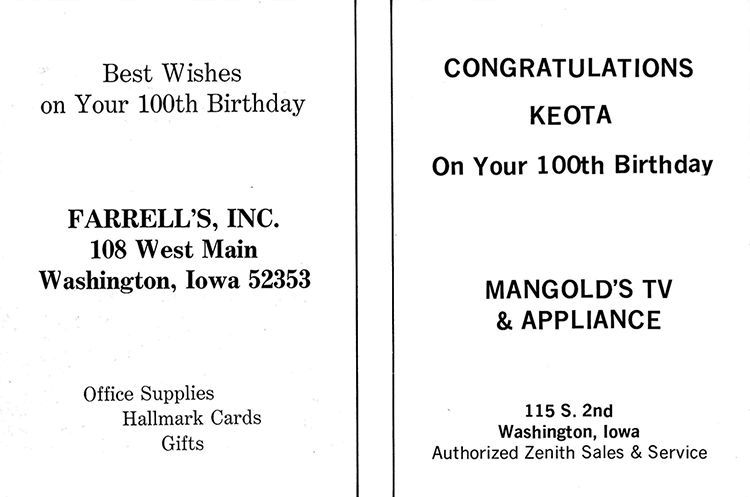
108
|

Columbian Hotel. Midway barber shop located in the Columbian
Hotel Block, 1 door north of the Columbian Hotel. Owned and
conducted by Sherman and Carris. 1895.
|
 |
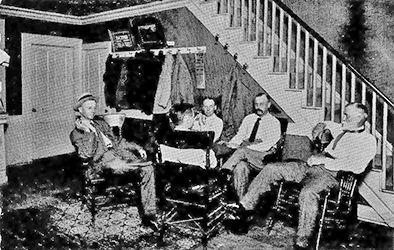
Lobby of Lindle Hotel |
109
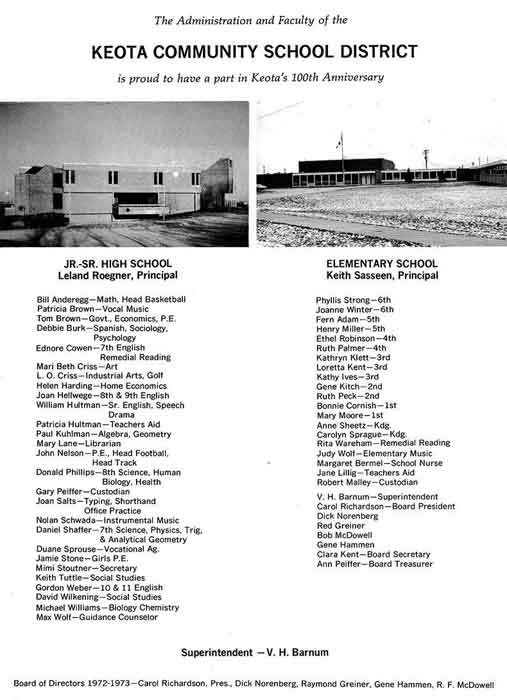
110
|
